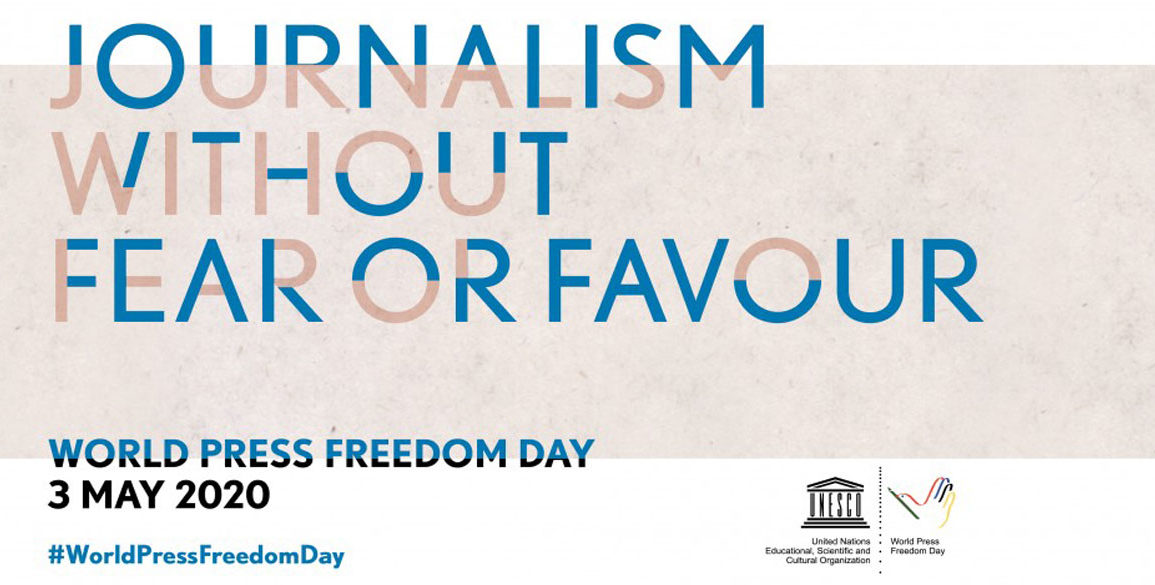May 3, 2020, marks the celebration of the 27th World Press Freedom Day. It was proclaimed by the UN General Assembly in December 1993, following the recommendation of UNESCO’s General Conference.
Every year, this day acts as a reminder to nations to ensure freedom of the press, and fulfil their commitment towards a free and fair media. It acts an opportunity to celebrate the freedom of the press, assess the state of press freedom throughout the world, defend media from attacks on its independence, and pay tribute to journalists who have lost their lives in the line of duty. The theme for this year’s World Press Freedom Day is “Journalism without Fear or Favour.”
One would believe that in a democracy like India, where freedom of expression is fortified within its Constitution, the liberty of the press to report without fear or favour would be protected. However, statistics prove otherwise. In 2019, India ranked 140th out 180 countries on the World Press Freedom Index. This number fell to 142 in 2020, with States like South Sudan and Palestine preceding India on the chart.
The descent in ranking may be attributed to a number of factors, such as instances of violence against media personnel, a decline in the independence of the press, increase in media gag, absence of pluralism, political/governmental influence on the media et al. According to Reporters sans frontières (Reporters without borders), in India, there have been constant press freedom violations, including police violence against journalists, ambushes by political activists, and reprisals instigated by criminal groups or corrupt local officials.
Instances of criminal prosecution of journalists for the offence of sedition under Section 124A, defamation under Section 500 of the Indian Penal Code, and legal action under the provisions of Unlawful Activities (Prevention) Act are on a rise. The rampant prosecution of media professionals indicates the existence of a narrow-minded society.
Freedom of press hit rock bottom in Kashmir in August 2019, when mobile connections and internet services in the valley were shut down by the Government. This restriction continued for several months, which made the operation of a free media impossible.
Anuradha Bhasin, executive editor of The Kashmir Times filed a writ petition before the Supreme Court inter alia contending that the cumulative effect of the restrictions imposed by the government adversely affected the freedom of the press in the Kashmir valley.
A 3-judge bench of the Supreme Court vide Order dated 10th January 2020 reiterated that freedom of speech and expression includes the right to disseminate information. The Court held that the freedom of speech and expression through the medium of internet is an integral part of Article 19(1) (a) and accordingly, any restriction on the same must be in accordance with Article 19(2) of the Constitution. It was observed that the Government must respect the freedom of the press at all times.
Subsequently, the complete restriction on internet in Kashmir was diluted by the Home Department of the State of Jammu & Kashmir vide Notification dated 24-01-2020, permitting 2G internet access to 301 Whitelist URLs. The suspension of 3G / 4G internet services, however, has been further extended to 11-05-2020 by a Government Order dated 27th April 2020 issued by the State of Jammu & Kashmir, citing security concerns.
The approach adopted by the Government directly impacts the freedom of the press in the country. A recent controversial stand taken by the Government in Public Interest Litigation petitions seeking redressal of grievances of migrants in different parts of the country is a classic example of shooting the messenger.
When the PIL came up for hearing, instead of focussing on the primary issue of panic-driven reverse migration, the Centre sought to deflect responsibility onto the media.
The Centre submitted that the mass exodus of migrant labourers was triggered by panic created by “fake news” that the lockdown would continue for more than 3 months, and sought a direction to prevent inaccurate reporting by the media. The Supreme Court, on the one hand, refrained from shackling the media, however, on the other hand, directed the media to refer to, and publish the official version about the developments surrounding COVID-19.
In India, a thread of judicial precedents emphasizes the significance of free and independent media in a democracy. The Supreme Court has consistently held the right to circulate one’s views as an integral part of the right guaranteed under Article 19(1) (a).
While Courts may attempt to rescue the press from unreasonable curtailments, multiple incidents of violence against journalists impede the freedom of the press. In a study titled “Getting away with murder” reported that between 2014-19, there have been 198 serious attacks on journalists across India.
It is highly unfortunate that there lies a deep-rooted aversion to divergent views in our society. The beauty of a democracy is embedded in the co-existence of contrasting opinions. Instances of violence against journalists cause cracks in the fourth pillar of democracy. Legislations to protect the media must be introduced and implemented in its true letter and spirit.
Protection of the media ensures independent and neutral reporting, which guarantees transparency in a democracy. As a society, we must work towards creating an environment of mutual respect for differing views. The co-existence of a pluralistic community can ensure freedom of the press to report without fear or favour.
Courtesy: The Leaflet







